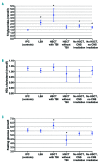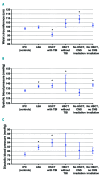Prevalence and characteristics of metabolic syndrome in adults from the French childhood leukemia survivors' cohort: a comparison with controls from the French population
- PMID: 29351982
- PMCID: PMC5865433
- DOI: 10.3324/haematol.2017.176123
Prevalence and characteristics of metabolic syndrome in adults from the French childhood leukemia survivors' cohort: a comparison with controls from the French population
Abstract
The prevalence of the metabolic syndrome among adults from the French LEA childhood acute leukemia survivors' cohort was prospectively evaluated considering the type of anti-leukemic treatment received, and compared with that of controls. The metabolic profile of these patients was compared with that of controls. A total of 3203 patients from a French volunteer cohort were age- and sex-matched 3:1 to 1025 leukemia survivors (in both cohorts, mean age: 24.4 years; females: 51%). Metabolic syndrome was defined according to the National Cholesterol Education Program's Adult Treatment Panel III criteria. Metabolic syndrome was found in 10.3% of patients (mean follow-up duration: 16.3±0.2 years) and 4.5% of controls, (OR=2.49; P<0.001). Patients transplanted with total body irradiation presented the highest risk (OR=6.26; P<0.001); the other treatment groups also showed a higher risk than controls, including patients treated with chemotherapy only. Odd Ratios were 1.68 (P=0.005) after chemotherapy only, 2.32 (P=0.002) after chemotherapy and cranial irradiation, and 2.18 (P=0.057) in patients transplanted without irradiation. Total body irradiation recipients with metabolic syndrome displayed a unique profile compared with controls: smaller waist circumference (91 vs 99.6 cm; P=0.01), and increased triglyceride levels (3.99 vs 1.5 mmol/L; P<0.001), fasting glucose levels (6.2 vs 5.6 mmol/L; P=0.049), and systolic blood pressure (137.9 vs 132.8 mmHg; P=0.005). By contrast, cranial irradiation recipients with metabolic syndrome had a larger waist circumference (109 vs 99.6 cm; P=0.007) than controls. Regardless of the anti-leukemic treatment, metabolic syndrome risk was higher among childhood leukemia survivors. Its presentation differed depending on the treatment type, thus suggesting a divergent pathophysiology. This study is registered at clinicaltrials.gov identifier: 01756599.
Trial registration: ClinicalTrials.gov NCT01756599.
Copyright© 2018 Ferrata Storti Foundation.
Figures


Similar articles
-
Metabolic syndrome in long-term survivors of childhood acute leukemia treated without hematopoietic stem cell transplantation: an L.E.A. study.Haematologica. 2016 Dec;101(12):1603-1610. doi: 10.3324/haematol.2016.148908. Epub 2016 Aug 11. Haematologica. 2016. PMID: 27515247 Free PMC article.
-
Cardiovascular Risk Factors in Survivors of Childhood Hematopoietic Cell Transplantation Treated with Total Body Irradiation: A Longitudinal Analysis.Biol Blood Marrow Transplant. 2017 Mar;23(3):475-482. doi: 10.1016/j.bbmt.2016.12.623. Epub 2016 Dec 28. Biol Blood Marrow Transplant. 2017. PMID: 28040534 Free PMC article.
-
Metabolic Syndrome in Male Survivors of Pediatric Allogeneic Hematopoietic Stem Cell Transplantation: Impact of Total Body Irradiation, Low-Grade Inflammation, and Hypogonadism.Transplant Cell Ther. 2021 Sep;27(9):778.e1-778.e8. doi: 10.1016/j.jtct.2021.05.025. Epub 2021 Jun 29. Transplant Cell Ther. 2021. PMID: 34091072
-
Type 2 Diabetes Mellitus, the Metabolic Syndrome, and Its Components in Adult Survivors of Acute Lymphoblastic Leukemia and Hematopoietic Stem Cell Transplantations.Curr Diab Rep. 2018 Apr 18;18(6):32. doi: 10.1007/s11892-018-0998-0. Curr Diab Rep. 2018. PMID: 29671081 Review.
-
Diabetes and Metabolic Syndrome in Survivors of Childhood Cancer.Horm Res Paediatr. 2019;91(2):118-127. doi: 10.1159/000495698. Epub 2019 Jan 16. Horm Res Paediatr. 2019. PMID: 30650414 Free PMC article. Review.
Cited by
-
Apolipoproteins-New Biomarkers of Overweight and Obesity among Childhood Acute Lymphoblastic Leukemia Survivors?Int J Mol Sci. 2022 Sep 13;23(18):10634. doi: 10.3390/ijms231810634. Int J Mol Sci. 2022. PMID: 36142534 Free PMC article.
-
Inflammatory biomarkers after an exercise intervention in childhood acute lymphoblastic leukemia survivors.EJHaem. 2022 Sep 29;3(4):1188-1200. doi: 10.1002/jha2.588. eCollection 2022 Nov. EJHaem. 2022. PMID: 36467791 Free PMC article.
-
Lipodystrophy-like features after total body irradiation among survivors of childhood acute leukemia.Endocr Connect. 2019 Apr;8(4):349-359. doi: 10.1530/EC-18-0497. Endocr Connect. 2019. PMID: 30844749 Free PMC article.
-
Vitamin D Deficiency and Carotid Media-Intima Thickness in Childhood Cancer Survivors.Nutrients. 2023 May 16;15(10):2333. doi: 10.3390/nu15102333. Nutrients. 2023. PMID: 37242216 Free PMC article.
-
2025 Heart Disease and Stroke Statistics: A Report of US and Global Data From the American Heart Association.Circulation. 2025 Feb 25;151(8):e41-e660. doi: 10.1161/CIR.0000000000001303. Epub 2025 Jan 27. Circulation. 2025. PMID: 39866113 Review.
References
-
- Hunger SP, Mullighan CG. Acute Lymphoblastic Leukemia in Children. N Engl J Med. 2015;373(16):1541–1552. - PubMed
-
- Creutzig U, Zimmermann M, Bourquin JP, et al. Randomized trial comparing liposomal daunorubicin with idarubicin as induction for pediatric acute myeloid leukemia: results from Study AML-BFM 2004. Blood. 2013;122(1):37–43. - PubMed
Publication types
MeSH terms
Substances
Associated data
LinkOut - more resources
Full Text Sources
Other Literature Sources
Medical

